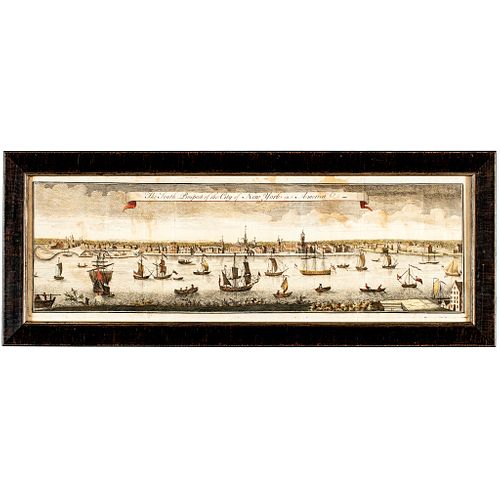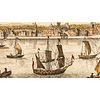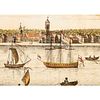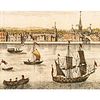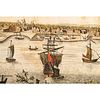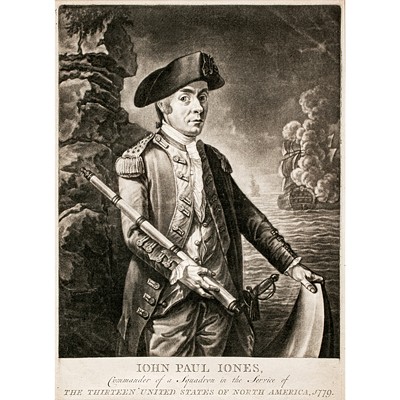1761 1st Published Print, The South Prospect of The City of New York In America
Lot 69
Categories
Estimate:
$3,000 - $4,000
Absentee vs Live bid
Two ways to bid:
- Leave a max absentee bid and the platform will bid on your behalf up to your maximum bid during the live auction.
- Bid live during the auction and your bids will be submitted real-time to the auctioneer.
Bid Increments
| Price | Bid Increment |
|---|---|
| $0 | $10 |
| $200 | $20 |
| $300 | $25 |
| $500 | $50 |
| $1,000 | $100 |
| $2,000 | $200 |
| $3,000 | $250 |
| $5,000 | $500 |
| $10,000 | $1,000 |
| $20,000 | $2,000 |
| $30,000 | $2,500 |
| $50,000 | $5,000 |
| $100,000 | $10,000 |
| $200,000 | $20,000 |
| $300,000 | $25,000 |
| $500,000 | $50,000 |
About Auction
By Early American History Auctions
Jan 23, 2021
Set Reminder
2021-01-23 12:00:00
2021-01-23 12:00:00
America/New_York
Bidsquare
Bidsquare : Early American History Auction of Autographs, Americana, Political & Maps
https://www.bidsquare.com/auctions/early-american-history-auctions/early-american-history-auction-of-autographs-americana-political-maps-6311
311 Lots of Rare, Historic Autographs, Americana, Civil War Era, George Washington, Abraham Lincoln, Slavery & Black History, Revolutionary War Era, Colonial America, Federal Period, War of 1812, Colonial Currency, Indian Peace Medals & more... Early American History Auctions auctions@earlyamerican.com
311 Lots of Rare, Historic Autographs, Americana, Civil War Era, George Washington, Abraham Lincoln, Slavery & Black History, Revolutionary War Era, Colonial America, Federal Period, War of 1812, Colonial Currency, Indian Peace Medals & more... Early American History Auctions auctions@earlyamerican.com
- Lot Description
Colonial America
"The South Prospect of The City of New York in America" the Rare Variant Edition, Issued as "New York in America"
1761 First Published Colonial Period, Rare Variant Edition Hand-Colored Copper-Plate Engraving titled, "The South Prospect of the City of New York in America," American Artist: Thomas, After William Burgis (active 1716-31), America, Framed, Choice Very Fine.
This colorful print offers a panoramic view of New York City from the South (more technically, the Southeast looking Northwest from Brooklyn) and it represents a rare American published variant of the 1761 version that was engraved for and published by the London Magazine. This is a relatively large Print that measures 21" x 6.5" (plate size) and does not have the printed header above the engraving reading, "Engraved For the London Magazine 1761," being the very rare varient edition. Because of their large horizontal size, they were folded and bound into each issue of the magazine. As a result, they all have six light vertical folds -- in the case of this print, the folds are barely visible and they are free of the typical distracting toning and dirt that often affected the exposed folds.
This beautiful Hand-Colored Engraving does have some light tone scattered about mostly in the upper central section into the margin, yet the impact on the visual eye appeal is negligible. A professional framer was engaged to place this example behind UV-Protection glass in what appears to be an antique frame (a nice blend of old and new technologies) to an overall size of 23.5" x 9.25". Also, this current Engraving is one of two editions of the City View, which were printed with separate copper plates. The clear difference is that the title differs in the other edition, as it includes the name, "New York in North America," rather than simply "America," as in this currently offered version of the view. While the two look nearly identical, there are many subtle differences, the most notable is that several of the sailing ships in this "America" edition do not have people aboard, whereas all the Sailing Ships on the "North America" edition include people aboard the Ships. A separate "Key" to this Map was included in the magazine and a reproduced copy of the Key is adhered seperately on the reverse of the frame. It highighted the following points of interest:
1. The Fort (today, Battery Park).
2. The Chapel, in the Fort.
3. The Secretary's Office.
4. The Great Dock, with a Bridge over it.
5. The Ruins of Whitehall, built by Governor Duncan.
6. Part of Nutten Island.
7. Part of Long Island.
8. The Lower Market.
9. The Crane.
10. The Great Flesh-Market.
11. The Dutch Church.
12. The English Church.
13. The City Hall.
14. The Exchange.
15. The French Church.
16. Upper Market.
17. The Station Ship.
18. The Wharf.
19. The Wharf for building ships.
20. The Ferry-House, on Long Island Side.
21. A Pen for Cattle, designed for the Market.
22. Colonel Morris's Fancy, turning to windward, with a Sloop of common mould.
(At the far right, the stockade shown would become Wall Street.)
This project began in 1716, when William Burgis drew the New York Waterfont from a vantage point on the Brooklyn Heights. The original artwork was converted into four copper plates that, together, measured six feet across. That version was printed in London, then sold to Americans through The American Weekly Mercury in 1721. The so-called "Bakewell reissue" was a copy from 1746.
The Engraved Print offered currently is of the 1761 Edition (as mentioned above), smaller in size, but equally impressive. It is ready for display, where it is sure to elicit lots of attention. A similar example, lacking the attribution to the London Magazine, can be located at the Yale University Art Gallery, in New Haven, Connecticut, where they attribute this as an American Engraved Print by artist Thomas. This is the very first example of the exceedingly rare 1761 Edition that we have offered.
This rarely encountered, extremely scarce early View of New York City, was first published in 1761.
Beginning in 1716, artist William Burgis stood at the Brooklyn Heights shore and drew the waterfront along the east side of Manhattan, calling it, "A South Prospect of the Flourishing City of New York in ye Province of New York in America." His drawing was sent to London, where John Harris engraved the image on four copper plates, which when printed and joined created a massive six-foot wide Panoramic View of the City, which was first advertised for sale in America in 1721 in "The American Weekly Mercury" as "A Curious Prospect of the City of New-York..."
That View was copied several times over the years, including the so-called 1746 "Bakewell Reissue," and in 1761 a new impression was engraved for the London Magazine.
This is one of two editions of the View, which were printed with separate copper plates. The clear difference is that the title differs in the other edition, as it includes the name "New York in North America," rather than simply "America," as in this version of the view. While the two look nearly identical, there are many subtle differences, the most notable is that several of the sailing ships in this "America" edition do not have people aboard, whereas all the sailing ships on the "North America" edition include people aboard the ships.
At the far right, the stockade shown would become Wall Street.
- Shipping Info
-
Early American provides in-house worldwide shipping. Please contact us directly if you have questions about your specific shipping requirements.
-
- Buyer's Premium



 EUR
EUR CAD
CAD AUD
AUD GBP
GBP MXN
MXN HKD
HKD CNY
CNY MYR
MYR SEK
SEK SGD
SGD CHF
CHF THB
THB